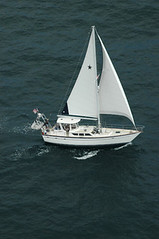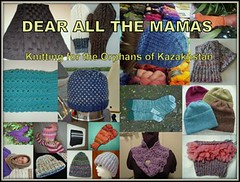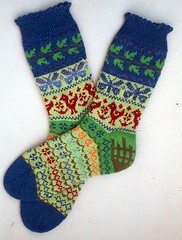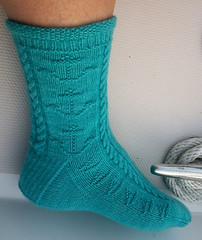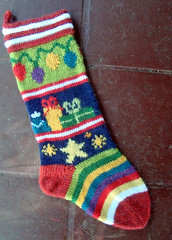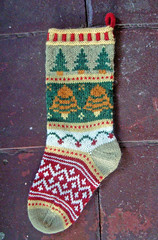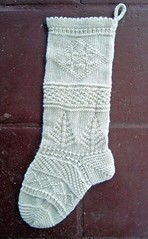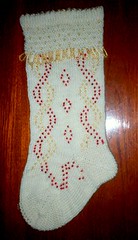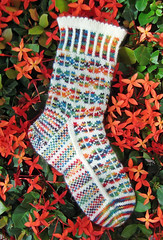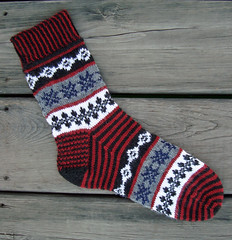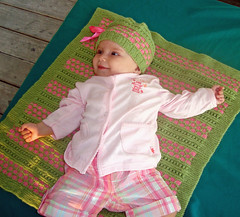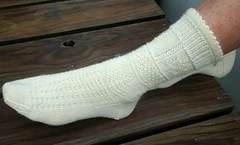
Wednesday, December 31, 2008
Frilly Aprons, Machetes, & Secret Underpanties
 Every Tuesday and Friday are market
Every Tuesday and Friday are market days in Usulutan - the nearest town to where we are moored here in El Salvador. We always go along in the private van even if we don't need to shop. It's entertaining and educational to go watch the local people and try new foods.
days in Usulutan - the nearest town to where we are moored here in El Salvador. We always go along in the private van even if we don't need to shop. It's entertaining and educational to go watch the local people and try new foods. When was the last time you saw a woman wearing an apron - a FRILLY apron? Yeah, I thought so, my grandmother wore one when she cooked too, but never out in public. Well, these little beauties are extremely popular here. The variety of styles are endless, but one thing is the same...they all have
 lots of emblishments of lace, riffles, ribbons, etc. and they have a secret zipper compartment(s) for the wearer's valuables.
lots of emblishments of lace, riffles, ribbons, etc. and they have a secret zipper compartment(s) for the wearer's valuables. Pickpockets, purse-snatchers, and other common theives are quite common here. These aprons provide a little security. No purses to snatch. You want to know what else? The women also wear special secret underpantie s!
s!
 s!
s! No...I'm not kidding. I actually bought some too. The seller told me to put Jonesy's wallet in the special pockets for safe keeping too. So...who gets to fish out the wallet when it is needed?
The first pair I found only cost $1US! The pocket is in the center front. Hmmmm....I don't want to put too much in here as it will just make my tummy look bigger. The next pair I bought cost twice as much ($2), but had TWO zip per pockets.
per pockets.
 per pockets.
per pockets. Yes, I wea r these now with my skirts and only carry a plastic market basket into town. No purse. And yes, I wear either long pants or a skirt as that is the local custom and I don't like to stand out as a gringo tourist. I also wear sunglasses as much as possible to hide my blue eyes. I find that people stare at me a lot less if they don't see my eyes.
r these now with my skirts and only carry a plastic market basket into town. No purse. And yes, I wear either long pants or a skirt as that is the local custom and I don't like to stand out as a gringo tourist. I also wear sunglasses as much as possible to hide my blue eyes. I find that people stare at me a lot less if they don't see my eyes.
Did you also notice that these underpanties have long legs? Yep - no "chub-rub" of the inner thigh with these! That was one of the first things I wondered about when I noticed that most of the women my age (and anyone over 18) wore skirts, and were shaped like me. How do th
shaped like me. How do th ey prevent chub-rub? And these are the answer! They are great!
ey prevent chub-rub? And these are the answer! They are great!
 r these now with my skirts and only carry a plastic market basket into town. No purse. And yes, I wear either long pants or a skirt as that is the local custom and I don't like to stand out as a gringo tourist. I also wear sunglasses as much as possible to hide my blue eyes. I find that people stare at me a lot less if they don't see my eyes.
r these now with my skirts and only carry a plastic market basket into town. No purse. And yes, I wear either long pants or a skirt as that is the local custom and I don't like to stand out as a gringo tourist. I also wear sunglasses as much as possible to hide my blue eyes. I find that people stare at me a lot less if they don't see my eyes.Did you also notice that these underpanties have long legs? Yep - no "chub-rub" of the inner thigh with these! That was one of the first things I wondered about when I noticed that most of the women my age (and anyone over 18) wore skirts, and were
 shaped like me. How do th
shaped like me. How do th ey prevent chub-rub? And these are the answer! They are great!
ey prevent chub-rub? And these are the answer! They are great!Another thing we noticed is that quite a few of the men carry machetes with them. Often they are carried in decorative leather sheaths. Okay. So, I'm a man, and I have to go to town to buy something, and to eat at the local cafeteria, and I need to carry my great big knife with me? I guess if you are Salvadoran then the answer is yes.
Even the street-sweeper guys carried machetes. So, I scoop up some litter and put it in my wheelbarrow topped with a basket, lop off a guy's arm, or cut some sugarcane, and continue down the street?
Even the street-sweeper guys carried machetes. So, I scoop up some litter and put it in my wheelbarrow topped with a basket, lop off a guy's arm, or cut some sugarcane, and continue down the street?

I think it's more of a macho thing. Ah, Latin America. I guess it's better than a concealed gun like in the USA. Speaking of which, men also wear a lot of automatic weapons and pistols here. Even to "guard" the local ice cream parlor there is a uniformed man with an automatic rifle slung over his shoulder.
DOGS
The dogs of El Salvador don't appear as healthy or as numerous as in Mexico. What is also odd is that they all look alike - that feral yellow short-ha ired dog look.
ired dog look.
Salvadorans live behind high walls with razor wire on top. They may have happy, clean doggies hidden away with them. So all we see are the street dogs.
 ired dog look.
ired dog look.Salvadorans live behind high walls with razor wire on top. They may have happy, clean doggies hidden away with them. So all we see are the street dogs.
These poor beasts break my heart.
Monday, December 29, 2008
El Salvador, Central America
 El Salvador...land of chocolate, volcanoes, bicycles, and sugarcane fields. Here's a photo of the Niki Wiki on a mooring ball here in the Barillas Marina Club in Jiquilisco Bay. Yes, that IS a volcano in the background, the active San Miguel volcano to be specific, which last erupted in 2002.
El Salvador...land of chocolate, volcanoes, bicycles, and sugarcane fields. Here's a photo of the Niki Wiki on a mooring ball here in the Barillas Marina Club in Jiquilisco Bay. Yes, that IS a volcano in the background, the active San Miguel volcano to be specific, which last erupted in 2002.We are 9 miles up a river estuary in the mangroves. Yes, there are biting bugs. But, there is also other wildlife that hasn't bitten us (yet). Each morning we are awakened by the sounds of the birds - we've seen collared forest falcons, osprey, great blue herons, yellow crested herons, mangrove swallows, egrets, and of course, the noisy grackles. Then there are the racoons, and the occasional crocodile.
What have we been doing? Well, first
 a photo of a pair of quick generic socks for Jonesy that came off the needles right before we left Mexico. The yarn is Regia stretch - my first time using this yarn. Jonesy wore them today for the first time so I'll save my final opinion on the yarn until after a few washings. More photos to come of the 3 more pairs of men's socks that I knit since then. I turned off my designing brain and just knit generic socks while we traveled. After working so hard on the Holiday Mystery Gift patterns I needed to unwind.
a photo of a pair of quick generic socks for Jonesy that came off the needles right before we left Mexico. The yarn is Regia stretch - my first time using this yarn. Jonesy wore them today for the first time so I'll save my final opinion on the yarn until after a few washings. More photos to come of the 3 more pairs of men's socks that I knit since then. I turned off my designing brain and just knit generic socks while we traveled. After working so hard on the Holiday Mystery Gift patterns I needed to unwind.We've been busy with drives (rides in a free van with a driver) into the nearest town (Usulutan) about 45 minutes away twice a week for basic provisioning and visits to the dentist for Jonesy in San Salvador. Wouldn't you know it? Just as we left Mexico for the 4-night, 5-day nonstop passage to El Salvador, Jonesy got a toothache.

And it was a big one. I started him on antibiotics just in case it was an abcess - it turned out it was. He suffered the whole trip. Thankfully, the motoring & sailing across the gulf of Tehuantepec was almost a non-event. No winds, calm seas, clear skies, very smooth going.
The same day that we arrived at the Barillas Marina Club, the manager got a dentist appointment for Jonesy and off we went. First the 45 minute ride to Usulutan (about half of that trip is on the dirt road pictured here going through the sugarcane fields and cacao forests). That dentist referred him to a specialist in San Salvador 2 1/2 hours away for treatment (root canals). The manager here in the marina got a SAME DAY appointment at the specialist and arranged a van to take us there. WOW! What personal service!
Today was his 3rd visit to the specialist (at $100 per 5-hour round trip with private driver) and he's out of pain. Now just a couple more visits to the first dentist for a crown and he'll be good to go
 again. Excellent dental experience - the endodontist was trained in the USA - Conneticut. The cost? $250 US - less than what the deductible would have been with our old insurance back when we worked at jobs (sorry I used that dirty 4-letter word - jobs). We'll see what the crown costs later this week.
again. Excellent dental experience - the endodontist was trained in the USA - Conneticut. The cost? $250 US - less than what the deductible would have been with our old insurance back when we worked at jobs (sorry I used that dirty 4-letter word - jobs). We'll see what the crown costs later this week.So... I mentioned cacao forests. Yep - we're talking chocolate in the rough. See, the cocoa pods grow along the trunks and branches of the cacao tree, which grows in the shade of old growth giant trees. Here is me with a little tree at the club. And below is one of the pods cut open.
I was shown that you could eat the fruit inside that surrounds the seeds (later called beans) and I tried it. Not special. Just really slimy. Snot slimy. Eeeew. In order to become cocoa beans the seeds have to ferment for a few days, I'd rather not think about that.
At the open-air market in town I bought a chunk of chocolate about the size of
 a can of beer for 80 cents. It is the BEST chocolate - as it melts in my mouth, a rich floral smell rises up my nose and I actually close my eyes and make little murmuring noises. The sugar is a little grainy, but for the flavor I'll overlook the crunch.
a can of beer for 80 cents. It is the BEST chocolate - as it melts in my mouth, a rich floral smell rises up my nose and I actually close my eyes and make little murmuring noises. The sugar is a little grainy, but for the flavor I'll overlook the crunch.
Oh, and I did decorate for Christmas this year. See? I hung up the ornaments.
More later ... the cheeseburgers and real french fries have been delivered to the table. We're sitting in the dark under thatched roof picnic tables using the free WiFi in the pool area.
Thursday, December 25, 2008
Market Day in Tlacolula, Oaxaca Mexico

 From Oaxaca, we took the local bus for the ride out to Tlacolula, a smaller town in the Oaxaca Valley area. The bus station was in a very seedy, garbage-strewn part of town and was difficult to find in all the chaos, but we managed to find it by asking a lot of questions. We paid the
From Oaxaca, we took the local bus for the ride out to Tlacolula, a smaller town in the Oaxaca Valley area. The bus station was in a very seedy, garbage-strewn part of town and was difficult to find in all the chaos, but we managed to find it by asking a lot of questions. We paid the  approx. $1 US each for the 20 minute ride and headed out of town to Tlacolula. Along the way we picked up more passengers until we had an over-full bus, then we just passed by the folks waiting along the road.
approx. $1 US each for the 20 minute ride and headed out of town to Tlacolula. Along the way we picked up more passengers until we had an over-full bus, then we just passed by the folks waiting along the road.Tlacolula has the oldest and largest “market” in the valley. Every Sunday, folks from other small villages in the valley, including the indigenous peoples come to buy and sell all sorts of mostly basic goods. Whatever you really need can be found there.
We were looking to buy a couple of handwoven wool rugs made by the Zapotec people of the village of Teotitlan del Valle. I had been eyeing these beauties in some of the better shops throughout Mexico for the last couple of years. I wanted to buy m
 ine directly from the family who wove them so that I could get the most money to the craftsperson and have a chance to meet them personally too.
ine directly from the family who wove them so that I could get the most money to the craftsperson and have a chance to meet them personally too.The “market” is held both outdoors along several streets, and indoors in a large building which houses the baked goods, fresh flowers, food stalls, and more. The most active, colorful, noisy (lots of non-spanish/local dialect spoken), and crowded areas were out in the streets. Want to buy some fried grasshoppers? These chapulines are a local t
 reat. No…I didn’t even try one.
reat. No…I didn’t even try one.How about a couple of live chickens or turkeys with their feet tied together? We saw several folks walking around the market carrying the chickens hanging upside down by their feet. The chickens were amazingly calm. Why? I don’t
 know. We think that folks were buying them as breeding pairs as they looked to be a hen and a cock in each pair, and there was plenty of fresh already-slaughtered and cleaned chicken available in the interior market building. But then, if you lived many hours away up in the hills and had no refrigeration, then maybe you DO buy your chickens alive.
know. We think that folks were buying them as breeding pairs as they looked to be a hen and a cock in each pair, and there was plenty of fresh already-slaughtered and cleaned chicken available in the interior market building. But then, if you lived many hours away up in the hills and had no refrigeration, then maybe you DO buy your chickens alive.
Chilies, both fresh and dried were in abundance and their spicy aroma was wonderful! You could even buy meat, vegetables, and the extra large & thin tortillas and they would cook it all for you in the indoor market.

Look at all of the colorful clothing worn by the local women! Where do they buy
 their embroidered aprons, ribbons and embroidery yarns? Right here in the market of course! No wool yarn though. I kept my eyes peeled for some, but didn’t see any. Is your stone mano (roller) or metate (slab) worn out? In the market you can test drive ne
their embroidered aprons, ribbons and embroidery yarns? Right here in the market of course! No wool yarn though. I kept my eyes peeled for some, but didn’t see any. Is your stone mano (roller) or metate (slab) worn out? In the market you can test drive ne w, lovely painted metates for grinding your corn. Both pieces are carved from stone and the vendor also sold the bowls for grinding your chilies.
w, lovely painted metates for grinding your corn. Both pieces are carved from stone and the vendor also sold the bowls for grinding your chilies. Finally, we found the street where all the handwoven rugs were being sold. Now we had to make the difficult choices – so many beautiful rugs to choose from. We checked out several stalls…looking…looking…and then we saw IT.
Finally, we found the street where all the handwoven rugs were being sold. Now we had to make the difficult choices – so many beautiful rugs to choose from. We checked out several stalls…looking…looking…and then we saw IT.Yep. It was the one. The
 weaver showed us several more styles and sizes and we again found another, smaller rug for our stateroom. Because we were buying two rugs, the price was bargained (gently) down – total cost for these two works
weaver showed us several more styles and sizes and we again found another, smaller rug for our stateroom. Because we were buying two rugs, the price was bargained (gently) down – total cost for these two works  of art? About $70 US dollars for two 100% wool handwoven rugs.
of art? About $70 US dollars for two 100% wool handwoven rugs.What a day! We woofed down a couple of tacos, flagged down the bus again and headed back into the city of Oaxaca to our hotel. Our heads were spinning with all that we saw, heard, and smelled - and still are!
Sunday, December 21, 2008
Oaxaca City, Mexico
We've safely arrived here in El Salvador! More later on that...here's what we did in our last port:
 Our big inland trip this year was up to the city of Oaxaca in Mexico! Whooo hoooo road trip. Just a 10-hour bus ride (each way) up a winding 2-lane highway. Usually there were steep cliffs on one side. Every few miles, there were little crosses and shrines set up along the side of the road to honor loved ones who lost their lives traveling this road. Are we feeling warm and fuzzy yet? Well, how about the fact that most drivers, including the busses and trucks consider a double-yellow line and 2 lanes to be really a 3-lane highway with a passing lane in the center?
Our big inland trip this year was up to the city of Oaxaca in Mexico! Whooo hoooo road trip. Just a 10-hour bus ride (each way) up a winding 2-lane highway. Usually there were steep cliffs on one side. Every few miles, there were little crosses and shrines set up along the side of the road to honor loved ones who lost their lives traveling this road. Are we feeling warm and fuzzy yet? Well, how about the fact that most drivers, including the busses and trucks consider a double-yellow line and 2 lanes to be really a 3-lane highway with a passing lane in the center?
Yep, that's what they do - the bus driver would pull out to pass a slow truck and he would straddle the yellow line. As a another vehicle would approach - usually around a blind curve - the other ve hicle would pull over slightly but continue towards us. At one point there would be 3 vehicles in the same part of the road. Two going one direction and one going the other. Yep. Not just occasionally, but very, very often. It really helps not to look. Read, knit, look out the side window. Just don't watch what the driver or the other guys are doing on the road.
hicle would pull over slightly but continue towards us. At one point there would be 3 vehicles in the same part of the road. Two going one direction and one going the other. Yep. Not just occasionally, but very, very often. It really helps not to look. Read, knit, look out the side window. Just don't watch what the driver or the other guys are doing on the road.
Obviously, we survived both directions of travel as I'm writing this blog now! Anyway, Oaxaca City (pronounced wah-HAH-cah) is a very old colonial city with some beautiful buildings. Unfortunately, earthquakes have ravaged many of the o ld buildings and they are abandoned. Just glancing down the street it's hard to tell which buildings are occupied and which are n
ld buildings and they are abandoned. Just glancing down the street it's hard to tell which buildings are occupied and which are n ot - but up-close it is easy to spot the sad, old buildings. The original building materials and construction methods can't stand up to the earth's rumblings.
ot - but up-close it is easy to spot the sad, old buildings. The original building materials and construction methods can't stand up to the earth's rumblings.
There are old cathedrals and historical official buildings everywhere around the city. We enjoyed sitting at various sidewalk cafes that surround the central town square (zocolo), drinking excellent coffee, eating the l ocal foods, and people watching. The woman below is wearing a traditional dress (huipil) which is handwoven cotton with broad satin ribbons sewn on it. There a
ocal foods, and people watching. The woman below is wearing a traditional dress (huipil) which is handwoven cotton with broad satin ribbons sewn on it. There a re several different groups of
re several different groups of  indiginous peoples and each wear their own style of clothing - women only. All men seemed to wear western-style clothing.
indiginous peoples and each wear their own style of clothing - women only. All men seemed to wear western-style clothing.
And...as usual in Mexico, the sidewalks are often "interesting". Here is a photo of a place where they have placed a telephone pole in the middle of a sidewalk...at the same place where the owner of the house has installed a window & balcony which juts out into the sidewalk. Oh, and then this truck parked right at the curb so you can't just walk around the pole. See that sign up on the pole of the E with the universal red "NO" circle and slash? Well, that is a "No Parking" sign. Whatever. Mexico.
Finally! I found some knitted objects for sale - and they were WOOL! Yes!! These little hats were knit with natural colored wool. Check out all the amazing patterns
 used on these hats!
used on these hats!
 Our big inland trip this year was up to the city of Oaxaca in Mexico! Whooo hoooo road trip. Just a 10-hour bus ride (each way) up a winding 2-lane highway. Usually there were steep cliffs on one side. Every few miles, there were little crosses and shrines set up along the side of the road to honor loved ones who lost their lives traveling this road. Are we feeling warm and fuzzy yet? Well, how about the fact that most drivers, including the busses and trucks consider a double-yellow line and 2 lanes to be really a 3-lane highway with a passing lane in the center?
Our big inland trip this year was up to the city of Oaxaca in Mexico! Whooo hoooo road trip. Just a 10-hour bus ride (each way) up a winding 2-lane highway. Usually there were steep cliffs on one side. Every few miles, there were little crosses and shrines set up along the side of the road to honor loved ones who lost their lives traveling this road. Are we feeling warm and fuzzy yet? Well, how about the fact that most drivers, including the busses and trucks consider a double-yellow line and 2 lanes to be really a 3-lane highway with a passing lane in the center?Yep, that's what they do - the bus driver would pull out to pass a slow truck and he would straddle the yellow line. As a another vehicle would approach - usually around a blind curve - the other ve
 hicle would pull over slightly but continue towards us. At one point there would be 3 vehicles in the same part of the road. Two going one direction and one going the other. Yep. Not just occasionally, but very, very often. It really helps not to look. Read, knit, look out the side window. Just don't watch what the driver or the other guys are doing on the road.
hicle would pull over slightly but continue towards us. At one point there would be 3 vehicles in the same part of the road. Two going one direction and one going the other. Yep. Not just occasionally, but very, very often. It really helps not to look. Read, knit, look out the side window. Just don't watch what the driver or the other guys are doing on the road.Obviously, we survived both directions of travel as I'm writing this blog now! Anyway, Oaxaca City (pronounced wah-HAH-cah) is a very old colonial city with some beautiful buildings. Unfortunately, earthquakes have ravaged many of the o
 ld buildings and they are abandoned. Just glancing down the street it's hard to tell which buildings are occupied and which are n
ld buildings and they are abandoned. Just glancing down the street it's hard to tell which buildings are occupied and which are n ot - but up-close it is easy to spot the sad, old buildings. The original building materials and construction methods can't stand up to the earth's rumblings.
ot - but up-close it is easy to spot the sad, old buildings. The original building materials and construction methods can't stand up to the earth's rumblings.There are old cathedrals and historical official buildings everywhere around the city. We enjoyed sitting at various sidewalk cafes that surround the central town square (zocolo), drinking excellent coffee, eating the l
 ocal foods, and people watching. The woman below is wearing a traditional dress (huipil) which is handwoven cotton with broad satin ribbons sewn on it. There a
ocal foods, and people watching. The woman below is wearing a traditional dress (huipil) which is handwoven cotton with broad satin ribbons sewn on it. There a re several different groups of
re several different groups of  indiginous peoples and each wear their own style of clothing - women only. All men seemed to wear western-style clothing.
indiginous peoples and each wear their own style of clothing - women only. All men seemed to wear western-style clothing. And...as usual in Mexico, the sidewalks are often "interesting". Here is a photo of a place where they have placed a telephone pole in the middle of a sidewalk...at the same place where the owner of the house has installed a window & balcony which juts out into the sidewalk. Oh, and then this truck parked right at the curb so you can't just walk around the pole. See that sign up on the pole of the E with the universal red "NO" circle and slash? Well, that is a "No Parking" sign. Whatever. Mexico.
Finally! I found some knitted objects for sale - and they were WOOL! Yes!! These little hats were knit with natural colored wool. Check out all the amazing patterns

 used on these hats!
used on these hats! Friday, December 12, 2008
Passage to Puerto Angel
 From Zihuatanejo, we set out for a 3-day, 2-night passage southeast along the coast of Mexico. Because we hadn't heard anything to change our minds about skipping Alcapulco, we motored on by this mega-tourist city at 3am. We could see the bright lights for many hours as we first approached, then left them behind. Remember...we are moving at about 5.5 to 6 knots or about 6 to 7 miles per hour.
From Zihuatanejo, we set out for a 3-day, 2-night passage southeast along the coast of Mexico. Because we hadn't heard anything to change our minds about skipping Alcapulco, we motored on by this mega-tourist city at 3am. We could see the bright lights for many hours as we first approached, then left them behind. Remember...we are moving at about 5.5 to 6 knots or about 6 to 7 miles per hour.We were always within sight of the coast which was almost all natural, uninhabited mountains and white sand beaches. Along the way we were visited by m
 any Brown Booby birds who would fly around the boat checking us out before they headed back out to sea. Many sea turtles floated by, both Green Turtles and the hump-backed Olive Ridley Turtle. Often, we would see little white birds riding along on the backs of the Olive Ridley turtles. But, they would always fly away before we could get close enough to get a photo.
any Brown Booby birds who would fly around the boat checking us out before they headed back out to sea. Many sea turtles floated by, both Green Turtles and the hump-backed Olive Ridley Turtle. Often, we would see little white birds riding along on the backs of the Olive Ridley turtles. But, they would always fly away before we could get close enough to get a photo.Several times we traveled along with schools of dolphins. We were twice treated to dolphins leaping up into the air, spinning as they surfaced. One of the days we kept scaring off large flocks of small white tern-like birds. They would be wildy diving and fis
 hing and at the same time trying to keep their distance from us. We saw small flying fish, and large leaping bill fish - were they Blue Marlins?
hing and at the same time trying to keep their distance from us. We saw small flying fish, and large leaping bill fish - were they Blue Marlins?At first we had calm seas and no wind so our passage was quite pleasant and the knitting was easy. At one point we had a strong (3-knot) current running WITH us so we were making 9 knots! Whoo hoooo! Speeding right along!
THE ATTACK OF THE LOG
But, 50 miles or so past Alcapulco, thankfully in daylight now, it happened. Niki Wiki rose up out of the sea and dropped back down again - HARD - as if we had hit a speed bump in the road! Not the usual tossing from mean waves - but a hard bump. What the heck was THAT? I jumped out of my berth and flew up the ladder to the cockpit where Jonesy was dumbstruck. A giant log had suddenly surfaced behind our boat. We had hit a log! What is the damage? Are we going to sink?
Jonesy practically threw himself down the companionway ladder to pull up the floor hatches and look into the bilge. No water coming in there. Next, we tossed
 the mattress off of our berth to look at the rudder mounting, sure we would see water gushing in. Nope. Dry. No water was coming in anywhere. We had surely dodged the bullet this time. There was really nothing we could do at the time except motorsail on towards our destination and watch for leaks.
the mattress off of our berth to look at the rudder mounting, sure we would see water gushing in. Nope. Dry. No water was coming in anywhere. We had surely dodged the bullet this time. There was really nothing we could do at the time except motorsail on towards our destination and watch for leaks.As we got closer to Puerto Angel, the seas started getting rough. The swells increased in size to what looked to be about 8 feet high. They were pushed by the opposing current which made them stand up in steep walls. The ride got pretty rough. Unfortunately, we had to change course eventu
 ally to make the turn into Puerto Angel. This would put us abeam of the seas and make the boat rock from side to side.
ally to make the turn into Puerto Angel. This would put us abeam of the seas and make the boat rock from side to side. 
What happens when we rock that way? Well, the bananas peeled themselves. The books and baskets of sailing magazines and knitting gear got tosssed behind the settee. Nope, the refrigerator stayed closed this time because I had made a new bungee strap to tie across the door so I didn't have to chase jars of mayonaise and jelly around the galley floor and mop up milk like last time. Also, the onions, jicamas, and avocados were fine because I
 had them stored in the red hanging basket in the galley.
had them stored in the red hanging basket in the galley.PUERTO ANGEL
Ahhhh....as soon as we got behind the shelter of a point of land, the seas instantly calmed and we slipped into tiny Puerto Angel in the state of Oaxaca, Mexico. This place is a little slice of heaven.
Two other sailboats were anchored in the tiny bay the day we arrived and we knew both of them! Friends! We choose a spot among the pangas (open fishing boats), and immediately I donned the snorkel gear to take a look at t he hull, rudder, and prop for any damage from our encounter with the log.
he hull, rudder, and prop for any damage from our encounter with the log.
 he hull, rudder, and prop for any damage from our encounter with the log.
he hull, rudder, and prop for any damage from our encounter with the log.All I could see was a white line running down one side of the hull/keel. No bent prop, no big gashes or holes, no twisted hardware on the rudder. We were so lucky! No, not lucky to have hit the log in the first place, but lucky to have no real damage. (A check later by a diver to clean the bottom of the boat confirmed that the bottom paint has been scraped off on the keel and maybe a "bump" in the front of the keel).
Above is a picture of Niki Wiki in the cente r of the photo at anchor in Puerto Angel with Playa Panteon in the background. We met the folks from the sailing vessels StarShine and Camelot for adult beverages and dinner in one of the beach palapas (open-air restaurants). Time to relax and enjoy the best part about cruising - - - the friends and lifestyles of the places we visit.
r of the photo at anchor in Puerto Angel with Playa Panteon in the background. We met the folks from the sailing vessels StarShine and Camelot for adult beverages and dinner in one of the beach palapas (open-air restaurants). Time to relax and enjoy the best part about cruising - - - the friends and lifestyles of the places we visit.
Above is a picture of Niki Wiki in the cente
 r of the photo at anchor in Puerto Angel with Playa Panteon in the background. We met the folks from the sailing vessels StarShine and Camelot for adult beverages and dinner in one of the beach palapas (open-air restaurants). Time to relax and enjoy the best part about cruising - - - the friends and lifestyles of the places we visit.
r of the photo at anchor in Puerto Angel with Playa Panteon in the background. We met the folks from the sailing vessels StarShine and Camelot for adult beverages and dinner in one of the beach palapas (open-air restaurants). Time to relax and enjoy the best part about cruising - - - the friends and lifestyles of the places we visit.Puerto An gel is first a fishing village, and now is also a retreat for folks looking for a quiet place. Pangas line the beach and zoom in and out all day long and at odd times throughout the night. Take a close look at the photos - do you see that the beach is very steep? How do the fishermen get their boats up on that hill you may ask.
gel is first a fishing village, and now is also a retreat for folks looking for a quiet place. Pangas line the beach and zoom in and out all day long and at odd times throughout the night. Take a close look at the photos - do you see that the beach is very steep? How do the fishermen get their boats up on that hill you may ask.
 gel is first a fishing village, and now is also a retreat for folks looking for a quiet place. Pangas line the beach and zoom in and out all day long and at odd times throughout the night. Take a close look at the photos - do you see that the beach is very steep? How do the fishermen get their boats up on that hill you may ask.
gel is first a fishing village, and now is also a retreat for folks looking for a quiet place. Pangas line the beach and zoom in and out all day long and at odd times throughout the night. Take a close look at the photos - do you see that the beach is very steep? How do the fishermen get their boats up on that hill you may ask.The answer is this: They wait out in the bay just off the the shore and watch the sea behind them. Just when they think a swell is coming in, they will gun their engine and zoom at full speed through the water, through the wave, and up onto the sand embankment. Yep, they use the forward motion of the boat to run up the steep sand dune. This takes some real guts for sure! 

When the fishermen aren't fishing, they still have chores. Their nets will occasionally need repair. Here in Puerto Angel, they spread the nets out across the sand and use nylon/plastic shuttles to make the loops and knots in the line.
make the loops and knots in the line.


When the fishermen aren't fishing, they still have chores. Their nets will occasionally need repair. Here in Puerto Angel, they spread the nets out across the sand and use nylon/plastic shuttles to
 make the loops and knots in the line.
make the loops and knots in the line.
FRIENDS
Meeting up with fellow cruisers in various places is a big part of this lifestyle. Making new friends is important too because as vagabonds, many of our friends take off to explore other parts of the world, ju st as we are moving south and east out of Mexico. Also, making local friends has been a real joy. We enjoy having leisurely conversations with the people we meet who run the little restaurants, drive the taxis or sell us produce out of the back of their pickup trucks.
st as we are moving south and east out of Mexico. Also, making local friends has been a real joy. We enjoy having leisurely conversations with the people we meet who run the little restaurants, drive the taxis or sell us produce out of the back of their pickup trucks.
 st as we are moving south and east out of Mexico. Also, making local friends has been a real joy. We enjoy having leisurely conversations with the people we meet who run the little restaurants, drive the taxis or sell us produce out of the back of their pickup trucks.
st as we are moving south and east out of Mexico. Also, making local friends has been a real joy. We enjoy having leisurely conversations with the people we meet who run the little restaurants, drive the taxis or sell us produce out of the back of their pickup trucks. The children are so curious and friendly too. Here is a photo of Jonesy talking about our dinghy engine with a group of boys. They were facinated by our small engine as their fathers all have big engines on their fishing pangas.
This group of young men/boys came paddling by in a canoe one afternoon. They were laughing and swimming and having a great time. As they approached our boat one of them asked if we had some water to share (a common request). I didn't have any bottled water, but I did hand them a plastic bag with boxed juice drinks and a peanut candy for each of them. They were thrilled! Immediately, they settled down with their goodies and just drifted along as they ate. Soon they were off hand-paddleing their canoe to other adventures. 
Keeping in touch with friends and family back in the USA is quite difficult for us.
Finding a wi-fi signal for internet email is always a challenge and sometimes impossible. But internet "cafes" are usually available even in very small towns. Here's a picture of Jonesy using the computer in Puerto Angel. See the colors of paint on the walls? Each wall, and the ceiling, is painted in a different shade of blue. You are seeing just about the whole place in this photo - just a concrete cell, painted blue with so me computers. But it worked.
me computers. But it worked.

Keeping in touch with friends and family back in the USA is quite difficult for us.
Finding a wi-fi signal for internet email is always a challenge and sometimes impossible. But internet "cafes" are usually available even in very small towns. Here's a picture of Jonesy using the computer in Puerto Angel. See the colors of paint on the walls? Each wall, and the ceiling, is painted in a different shade of blue. You are seeing just about the whole place in this photo - just a concrete cell, painted blue with so
 me computers. But it worked.
me computers. But it worked.Just behind the beach front restaurants is an old cemetery. We took a hike up the hill to look at the gravesites. Some were elaborate (painted blue, white, or green) handbuilt concrete tombs. But farther up the hill, the graves only had a wooden cross (or crosses). As the "Day of the Dead" holiday was a couple of weeks prior, the graves were littered with dead flowers and spent candles.
As we are folks who have moved around a lot, and are now such vagabonds we are awed by the fact  that there are families around to decorate all of the
that there are families around to decorate all of the  graves. We can only assume that people spent their whole lives here in Puerto Angel and eventually were buried here on the hill. Now, their offspring and their families honor them with visits.
graves. We can only assume that people spent their whole lives here in Puerto Angel and eventually were buried here on the hill. Now, their offspring and their families honor them with visits.
 that there are families around to decorate all of the
that there are families around to decorate all of the  graves. We can only assume that people spent their whole lives here in Puerto Angel and eventually were buried here on the hill. Now, their offspring and their families honor them with visits.
graves. We can only assume that people spent their whole lives here in Puerto Angel and eventually were buried here on the hill. Now, their offspring and their families honor them with visits.

